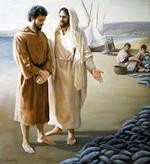Catholic World News News Feature
Vatican releases new rite for exorcism January 26, 1999
VATICAN (CWNews.com) -- The Devil exists. That unpopular reality is brought into sharp focus by the promulgation of a new rite of exorcism for the Catholic Church.
De Exorcismus et supplicationibus quibusdam, approved by Pope John Paul II on October 1, 1998, was formally released by the Vatican on January 26. The document sets out a new and precise liturgical form for the rite of exorcism. The 84-page form, introduced by the Congregation Divine Worship, was published entirely in Latin; the episcopal conferences of different nations may now prepare their own versions in the vernacular languages.
This new Vatican document clearly recognizes both the existence of the Devil and the reality of diabolical possession. In a short introduction, the document calls attention to the existence of both "angelic creatures" and others "called demons, who are opposed to God." Since the influence of the demonic can become apparent in people, places, or things, the document continues, the Church "has prayed, and continues to pray, that men will be freed from the snares of the Devil."
The new rite confirms "the victory of Christ and the power of the Church over the demons." It points to the rites in the Christian tradition: the "minor exorcism" of catechumens prior to their baptism and the major exorcisms conducted according to this ritual. The latter are designed to "drive out demons, or bring freedom from demonic influence, through the spiritual authority which Jesus confided in his Church."
The liturgical ritual itself is centered on supplicatory prayers, asking for God's help, and "imperative" prayers addressed directly to the Devil, commanding him to depart. The prayers are to be said as the exorcist lays his hand on the individual, and are part of an overall ritual which includes specific blessings and sprinklings with holy water. The ritual also includes the litany of the saints, the reading of the Psalms and the Gospel, and a proclamation of faith which may be either the familiar Creed or a simple question-and-answer ("Do you renounce Satan? I do."). The ritual concludes with the kissing of the Cross, and the final prayer, proclaiming the triumph of Christ and his Church.
The new ritual for exorcism replaces one which was promulgated as part of the Roman Ritual of 1614. The Second Vatican Council called for the revision of that Ritual, which has been accomplished in stages during the past 30 years; the rite of exorcism was the last of the new rituals to be introduced.
In introducing the new document to reporters in Rome, Cardinal Jorge Arturo Medina Estevez, the prefect of the Congregation for Divine Worship, said that the rite has not been greatly changed from the earlier ritual. He added that while there are "very few cases" in which the rite is used, the rite of exorcism-- which can only be used under the guidance of the local bishop, and with the consent of the person suffering diabolical possession-- remains necessary because the Devil is a reality. He cautioned that while many Catholics today no longer profess belief in the Devil, that belief "is not a matter of opinion which one can accept or reject; it is an element of faith and Catholic doctrine."






